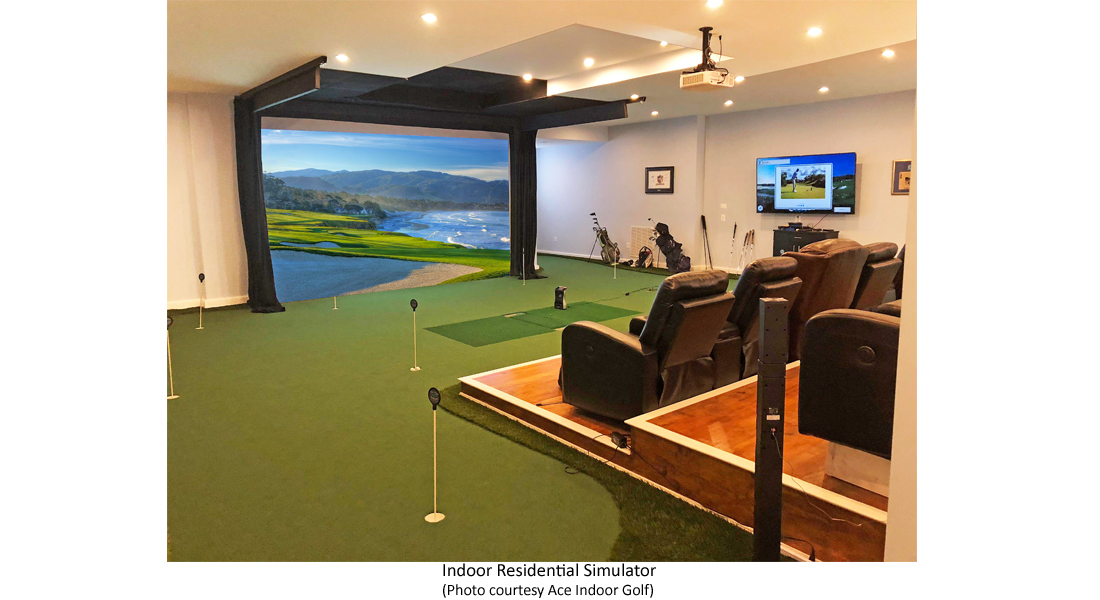
More and more people are participating in golf by taking advantage of sophisticated computer software to simulate the on-course experience hitting balls into screens showing the image of a golf hole.
According to the National Golf Foundation and quoting from their website, “An estimated 6.2 million Americans hit golf balls with a club in a golf simulator within the past year, a total that’s surged 73% compared to pre-pandemic levels. In 2019 and years prior, simulator participation had hovered just under 4 million.”
The data also points out most simulator users (53%) don’t play traditional green grass golf and one-third have used a simulator in a residence reflecting the increase in privately owned simulator setups.
The surge in simulator play runs the gamut from commercial ventures that charge a fee such as sports bars to golf retailers, instructors and fitters with multiple bays and home simulator installations costing several thousands of dollars.
Joe Neumeyer, founder and managing partner of Toledo, Ohio-based Ace Indoor Golf a leading provider of turnkey design and installation of residential and commercial simulator packages said in an interview earlier this year with this writer, “The golf simulator business is booming. It was valued at $1.3 billion worldwide this past year and is expected to grow at a 10 percent compound annual growth rate in the near future. Both commercial and residential installations saw significant growth in 2022.”
Neumeyer further revealed that residential and commercial business for Ace Indoor grew by more than 50% in 2022 and the growth has continued in 2023.
The simulator market is becoming increasingly crowded and at the PGA Show in January more than a dozen simulator software companies will have booth space including FlightScope, Foresight Sports, Full Swing Golf, SkyTrak, SmartGolf, Trackman, and Uneekor.
Additionally, as in the past Ace Indoor and other enclosure package sellers will be constructing simulator setups on the Show floor enabling companies to demonstrate their products such as swing analysis software as well as clubs.
Another aspect of simulators is the new six team TGL Golf simulator league begun by Tiger Woods and Rory McIlroy which was slated to compete in a purpose-built indoor venue with players hitting into a 64 by 46-foot screen that projects shot results for 1,600 fans in the arena plus a broadcast audience. However, due to a construction mishap at the arena league play has been pushed back a year to January of 2025.
It is obvious the participation in golf has split into roughly equal on-course and off-course segments making for a clear view of the future for our game. Referring to data again supplied by the National Golf Foundation, in 2022 there were 41.1 million golf participants in some form with 13.2 million only playing on-course, 15.5 million only off-course and 12.4 million doing both.
Off-course includes entertainment centers such as Topgolf and Drive Shack where balls are hit to driving range target areas without simulator screens. However, an increasing number of businesses do have screens for entertainment plus for teaching and club fitting retailers like Golf Galaxy, PGA Tour Superstore, Club Champion and GolfTec.
Industry insiders are paying close attention to the demographics of the 15 million+ off-course only participants which includes the 6.2 million making use of simulators. Compared with on-course golfers, off-course users are younger, having an average age of 31 years compared with 46 for on-course. The portion of females is much higher, 41% versus 28% as is the percentage of non-whites, 40% versus 22% on-course.
As yet few traditional golf clubs have made an investment in a simulator experience for their members which is similar to how workout facilities were treated 30 years ago. But that will change as golf clubs especially private clubs realize they are entertainment venues rather than just places to go hit a golf ball. The need to attract new members, particularly families, will force a change in thinking which indeed has already begun.
These numbers reflect the changing demographics of the U.S. population but also provide a clear pathway to the golf industry for continued growth by meeting the needs of a changing audience both current and potential.
